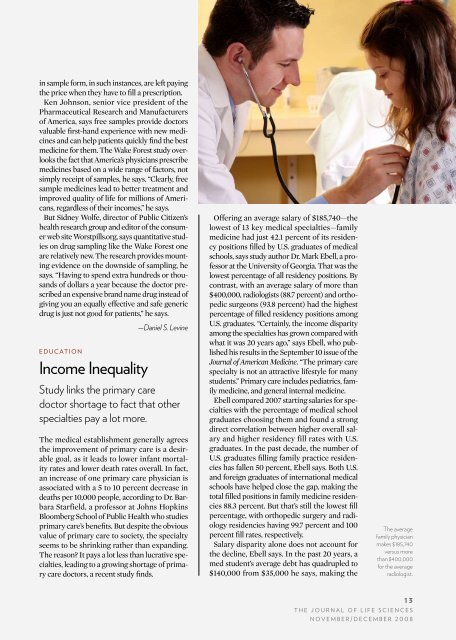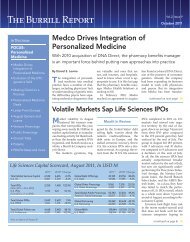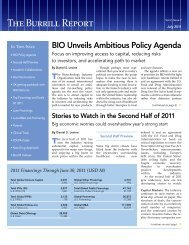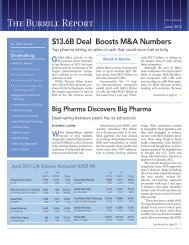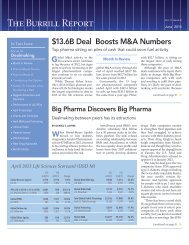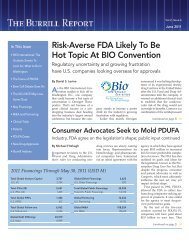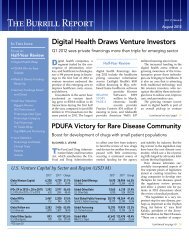The Sex Issue - The Burrill Report
The Sex Issue - The Burrill Report
The Sex Issue - The Burrill Report
You also want an ePaper? Increase the reach of your titles
YUMPU automatically turns print PDFs into web optimized ePapers that Google loves.
in sample form, in such instances, are left paying<br />
the price when they have to fill a prescription.<br />
Ken Johnson, senior vice president of the<br />
Pharmaceutical Research and Manufacturers<br />
of America, says free samples provide doctors<br />
valuable first-hand experience with new medicines<br />
and can help patients quickly find the best<br />
medicine for them. <strong>The</strong> Wake Forest study overlooks<br />
the fact that America’s physicians prescribe<br />
medicines based on a wide range of factors, not<br />
simply receipt of samples, he says. “Clearly, free<br />
sample medicines lead to better treatment and<br />
improved quality of life for millions of Americans,<br />
regardless of their incomes,” he says.<br />
But Sidney Wolfe, director of Public Citizen’s<br />
health research group and editor of the consumer<br />
web site Worstpills.org, says quantitative studies<br />
on drug sampling like the Wake Forest one<br />
are relatively new. <strong>The</strong> research provides mounting<br />
evidence on the downside of sampling, he<br />
says. “Having to spend extra hundreds or thousands<br />
of dollars a year because the doctor prescribed<br />
an expensive brand name drug instead of<br />
giving you an equally effective and safe generic<br />
drug is just not good for patients,” he says.<br />
EDUCATION<br />
Income Inequality<br />
—Daniel S. Levine<br />
Study links the primary care<br />
doctor shortage to fact that other<br />
specialties pay a lot more.<br />
<strong>The</strong> medical establishment generally agrees<br />
the improvement of primary care is a desirable<br />
goal, as it leads to lower infant mortality<br />
rates and lower death rates overall. In fact,<br />
an increase of one primary care physician is<br />
associated with a 5 to 10 percent decrease in<br />
deaths per 10,000 people, according to Dr. Barbara<br />
Starfield, a professor at Johns Hopkins<br />
Bloomberg School of Public Health who studies<br />
primary care’s benefits. But despite the obvious<br />
value of primary care to society, the specialty<br />
seems to be shrinking rather than expanding.<br />
<strong>The</strong> reason? It pays a lot less than lucrative specialties,<br />
leading to a growing shortage of primary<br />
care doctors, a recent study finds.<br />
Offering an average salary of $185,740—the<br />
lowest of 13 key medical specialties—family<br />
medicine had just 42.1 percent of its residency<br />
positions filled by U.S. graduates of medical<br />
schools, says study author Dr. Mark Ebell, a professor<br />
at the University of Georgia. That was the<br />
lowest percentage of all residency positions. By<br />
contrast, with an average salary of more than<br />
$400,000, radiologists (88.7 percent) and orthopedic<br />
surgeons (93.8 percent) had the highest<br />
percentage of filled residency positions among<br />
U.S. graduates. “Certainly, the income disparity<br />
among the specialties has grown compared with<br />
what it was 20 years ago,” says Ebell, who published<br />
his results in the September 10 issue of the<br />
Journal of American Medicine. “<strong>The</strong> primary care<br />
specialty is not an attractive lifestyle for many<br />
students.” Primary care includes pediatrics, family<br />
medicine, and general internal medicine.<br />
Ebell compared 2007 starting salaries for specialties<br />
with the percentage of medical school<br />
graduates choosing them and found a strong<br />
direct correlation between higher overall salary<br />
and higher residency fill rates with U.S.<br />
graduates. In the past decade, the number of<br />
U.S. graduates filling family practice residencies<br />
has fallen 50 percent, Ebell says. Both U.S.<br />
and foreign graduates of international medical<br />
schools have helped close the gap, making the<br />
total filled positions in family medicine residencies<br />
88.3 percent. But that’s still the lowest fill<br />
percentage, with orthopedic surgery and radiology<br />
residencies having 99.7 percent and 100<br />
percent fill rates, respectively.<br />
Salary disparity alone does not account for<br />
the decline, Ebell says. In the past 20 years, a<br />
med student’s average debt has quadrupled to<br />
$140,000 from $35,000 he says, making the<br />
<strong>The</strong> average<br />
family physician<br />
makes $185,740<br />
versus more<br />
than $400,000<br />
for the average<br />
radiologist.<br />
1 3<br />
<strong>The</strong> Journal of Life Sciences<br />
november/december 2008


